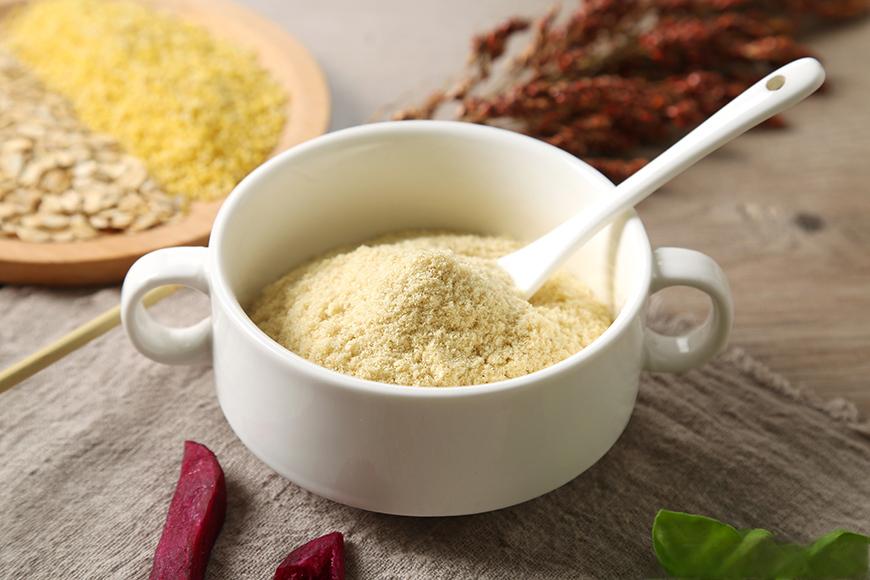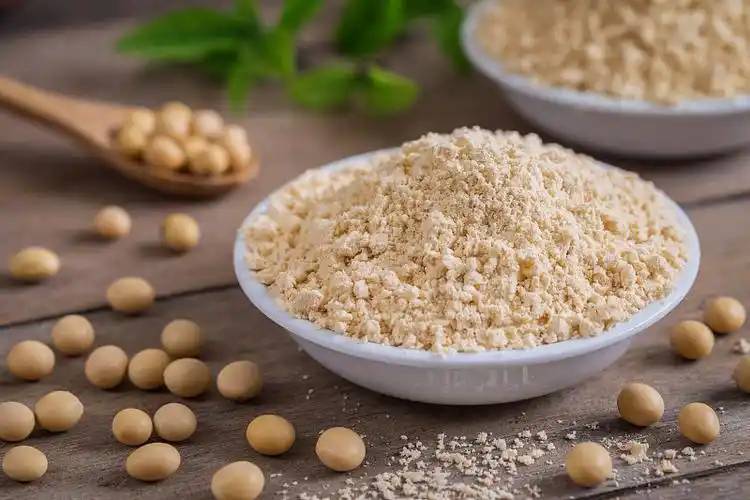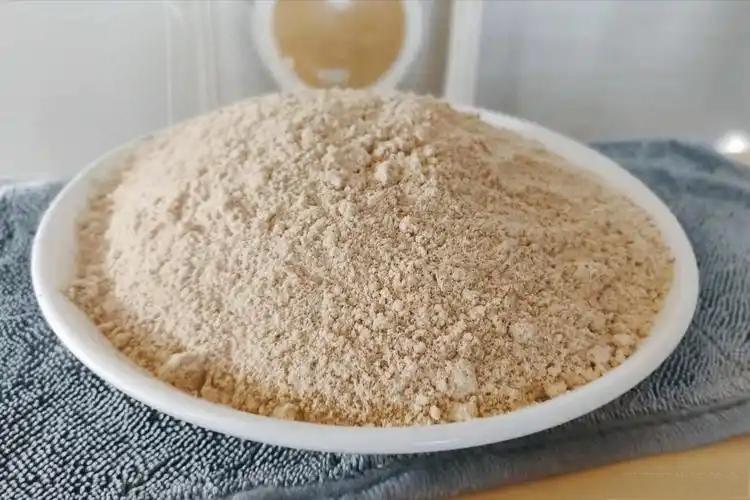What Is the Use of Soy Protein Powder in Vegetarian Food?
Vegetarianism, as a symbol of health and wellness, has always been known for its “purity, cleanliness, beauty, and vegetarianism” because it not only conforms to the theme of “environmental protection, health, and ecological balance” in the environment of the 21st century, but also can reduce the risk of diseases and shorten the range of high-risk groups, enhance the physical condition of human beings, and contribute to the harmony and unity of body and mind.
This is because a vegetarian diet is not only in line with the theme of “environmental health and ecological balance” in the 21st century environment, but also, on the premise of providing basic nutrition, it can reduce the risk of diseases, shorten the scope of high-risk groups, strengthen human physique, and be conducive to the harmony and unity of the body and the mind. Dr. Sun Yat-sen, when talking about the issue of “eating,” once said, “Only after the methods and means of human beings' earning their living are improved, do they know to eat plants. Mr. Albert Einstein also said Albert Einstein also said, “I believe that a vegetarian diet is an effect of human development and is therefore most useful for the enlightenment of mankind.” Nowadays, safe and healthy vegetarian diet has become a new trend in people's daily diet [1].
Soy protein is currently recognized as a high-quality plant protein with high nutritional and health values. The application of soy protein in traditional soybean products not only improves the nutritional value of the products, but also reduces the production cost of raw materials and facilitates processing [2, 3]. In retrospect, the history of soybean consumption in China is very long, in the sense of traditional soybean products, there are many kinds of soybeans, but there are inconvenient processing and the shortcomings of heavy soybean odor, so the effective removal of soybean histones of soybean odor is essential for the production of vegetarian products.
Soybean tissue protein deodorization methods are many, commonly used methods to remove the fishy smell of soybeans are physical (water soluble, heating, solvent, distillation, etc.), chemical (hydrogen peroxide, sulfites, etc.), masking (sucrose, organic acids or flavors, spices, etc.), enzymatic digestion, fermentation, etc. [4, 5]. With the development of the times and people's awareness of vegetarian diet, soy protein is also widely used in vegetarian diet. Soybean tissue protein is not only inexpensive, but also has good oil absorption, water absorption and emulsification properties. Moreover, after processing and pressure drying, the microbial content is significantly reduced, the shelf life is long and can be safely stored for about 1 year, and the structure of soybean tissue protein after rehydration is very similar to the structure of animal protein [6].
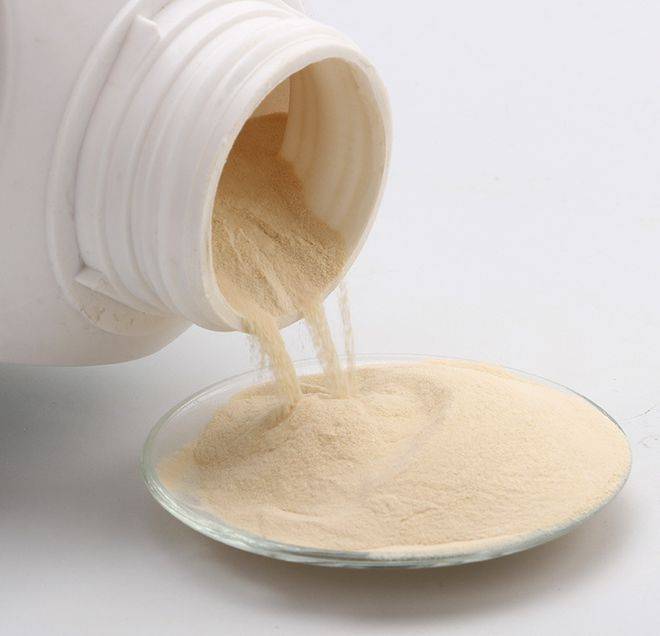
Foreign countries have long been using soy protein to produce vegetarian food, which is because soy protein has a high economic and nutritional value. Economy refers to the low price of soybean tissue protein products, can replace part of the meat, reduce product costs. The nutritional value refers to the richness of soy protein, which is about 40%. Adding soy protein as a major raw material to vegetarian meat products can increase the protein content of the products, reduce the content of animal fat and cholesterol, and meet the needs of modern nutrition. In addition, the unique functional properties of soy protein are also an important reason for its wide range of applications. The emulsifying, oil-absorbent, water-absorbent, gelatinizing, and adhesive properties of soy protein can be used to improve the quality of meat products [10-15].
Therefore, the application of soy protein in vegetarian food can not only improve the nutritional value of vegetarian food, improve the grade of the product, but also change the daily dietary structure of the people, in line with the market demand, and at the same time, provide more choices for many patients suffering from high blood pressure and other diseases, or health-conscious people, so as to expand the market capacity and meet the needs of more people [16-18]. Therefore, this article summarizes the development of soy protein in vegetarian food from the application of soy protein in vegetarian meat products, vegetarian fast food and vegetarian dishes.
1 Current research on soy protein in vegetarian meat products
Soy-based vegetarian meat products are popular because of their unique flavor, texture, and nutritional value, and they have become one of the most versatile high-protein food products in terms of development and research. There are many researchers conducting innovative research and development of new vegetarian food products, and there are also some who are selecting and blending product formulas, i.e., adding processed soy protein with seasonings to make vegetarian meat cubes with a strong flavor and suitable texture. Current research on the application of soy protein focuses mainly on vegetarian food products using soy protein as a raw material. Most of these foods are processed using soybean tissue protein twin-screw extrusion technology, so that the raw soy protein is fully absorbed and then dehydrated and finally put into a chopper to extract the silk, which makes the soy protein food products developed from the taste and texture of the people loved. Current research has found that most of the research on vegetarian meat products has focused on the production and improvement of vegetarian ham, vegetarian meat floss, vegetarian sausage, and vegetarian diced beef.
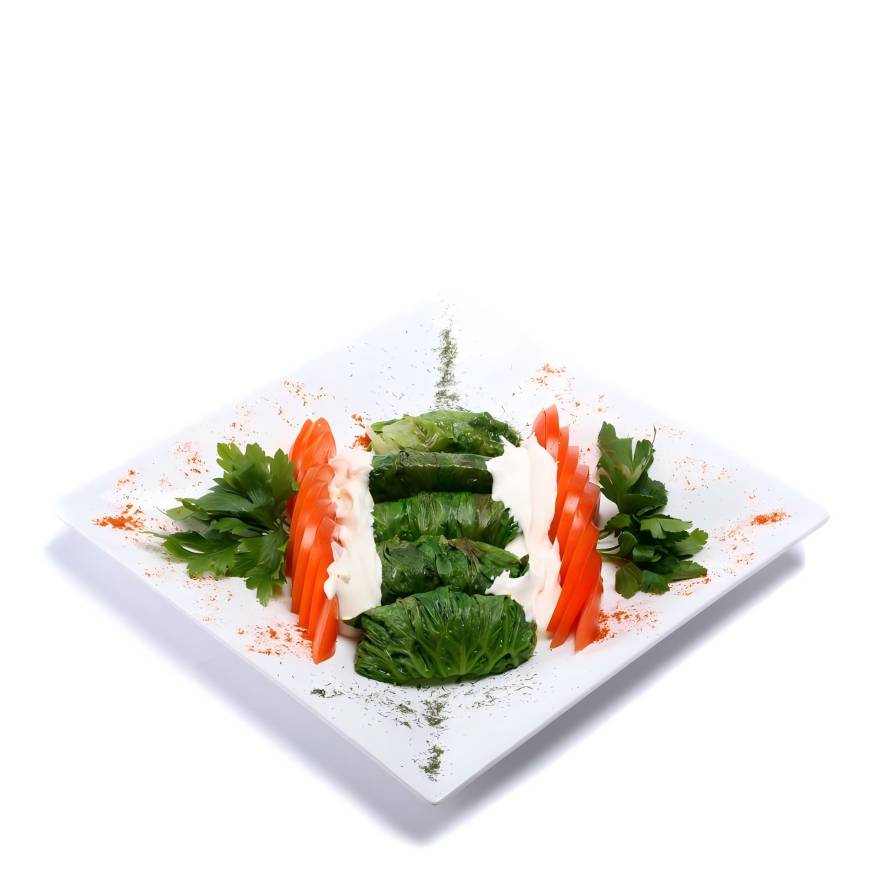
1.1 Vegetarian Ham
As one of the traditional Chinese foods, ham is very popular among people. Traditionally, ham is cured and processed, washed and dried on pig legs, and is called ham because of its red color [19, 20]. In recent years, traditional ham has been given a new life with the research of various professionals on soy protein related foods. The use of soy protein as a substitute for meat in the processing of vegetarian ham has also become a hot trend in food research.
Yingmin Fei [21] (2010) investigated the optimal recipe and process conditions for ham production using soy protein and gluten as the main raw materials, with the addition of starch, vegetable oils, and seasonings. The optimal ratios were determined as follows: soybean silk protein 31%, gluten 12%, potato starch 10%, soybean salad oil 5.0%, carrageenan 0.35%, nutmeg 0.5%, salt, flavoring, sugar, spices 4.15%, onion, ginger 3%, sesame oil 2%, veggie meat flavoring 3%, water 29%.
Deng Yuanxi [22] (2011) et al. studied the process of preparing vegetarian ham with soy protein as the main raw material, and researched the processing technology of vegetarian ham through one-way and orthogonal tests, and elaborated on the important influence of coagulant on the chewiness and viscoelasticity of vegetarian ham during the production process, and the best results were obtained when the concentration of marinade was 2.0mol/L; the concentration of CaSO4 was 0.25mol/L; and the temperature was 85 ℃. When the brine concentration is 2.0mol / L; CaSO4 concentration is 0.25mol / L; and the temperature is 85℃, the best effect is achieved.
Li Xuelian [23] (2007) et al. used soybean tissue protein and konjac flour as the basic raw materials, and made use of their structural characteristics to evaluate the sensory and nutritional aspects of the processed veggie ham, which was found to be relatively good in terms of sensory flexibility, but still needs to be strengthened, such as the surface of the ham was not smooth enough, and the moistness of the mouthfeel was poor. In terms of nutrition, the absence of added nitrites avoids the corresponding risks and the health benefits are superior.
These studies have provided a theoretical source for the analysis and evaluation of vegetarian ham, and have shown that it can be easily analyzed and implemented in future experiments. The feasibility of using soy protein as a substitute for meat in the processing of vegan hams has been demonstrated, and the use of soy protein as a substitute for meat in the processing of vegan hams is bound to become a hot trend in the development of foods for the ham market today.
1.2 Vegetarian Meat Loaf
Meat floss is a dried animal product that is very popular because of its high nutritional value and delicious taste. However, studies have shown that excessive consumption of animal meat can lead to hypertension, atherosclerosis and other cardiovascular diseases due to the varying levels of cholesterol [24, 25].
Considering the desire of different individuals to consume meat floss and the concern of cholesterol, Wang Jingji [26] (1998) developed a vegetarian meat floss product based on soy protein as a raw material, which is a newer soy-based health food compared to pure meat floss. Yang Xiaoyu [27] (2005) and others have also studied the production of vegetarian meat floss by soaking flakes of tissue protein in water and rolling them into threads, and through the analysis of texture characteristics and sensory evaluation, the optimal process and the optimal recipe for the production of vegetarian meat floss were determined, in which the amount of soybean tissue protein added was 8%. The addition of soy protein can greatly reduce the production cost of meat floss, which has a certain development prospect.
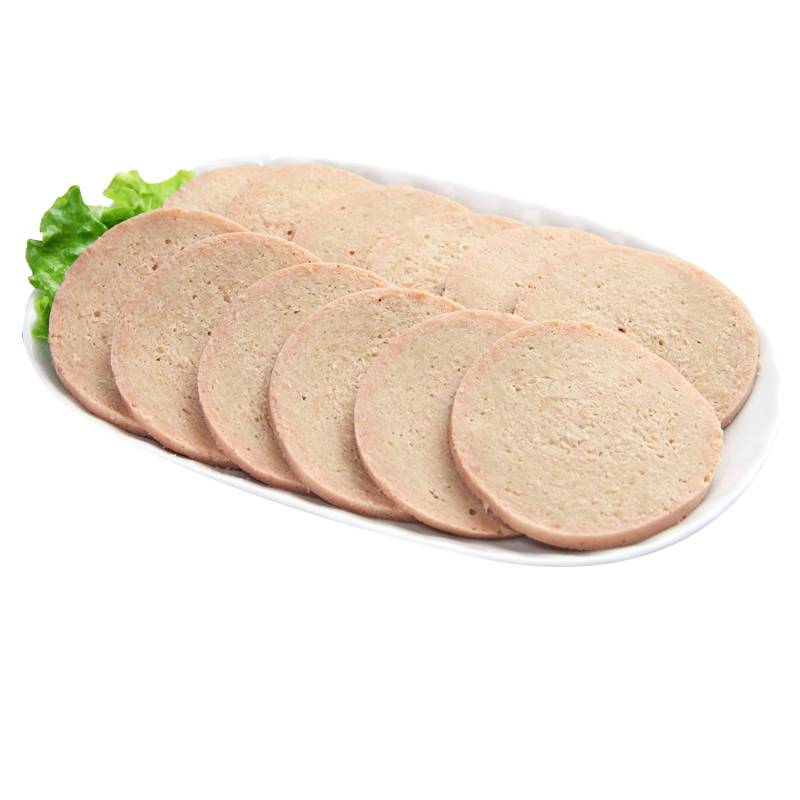
1.3 Vegetarian meat sausage
Meat sausage with ground meat, starch as the main raw material, after processing the unique flavor to give people a sense of lips and teeth.
Tang Zhaohui [28] (2007) and others first launched a special research in this aspect of the vegetarian sausage, mainly with soy protein as the main raw material, through a number of experiments to obtain the optimal ratio of soy protein and its seasoning, that is, when the ratio of soy protein, water and vegetable oil in the vegetarian sausage is 19.6∶46.7∶16.7, the taste and flavor of the vegetarian sausage is the best.
In addition, Yang Xiaoyu [27] (2005) also used soybean tissue protein as raw material, added soybean oil and carrageenan and other seasonings to make vegetarian sausage, and after a detailed analysis of data processing, it was concluded that carrageenan on the vegetarian sausage mainly comes from its brittleness, elasticity and toughness of the three main indicators, the three indicators also showed a strict correlation, when the amount of addition of 2:1:2 is the optimal ratio, in this case, the vegetarian intestine is the best taste and flavor, when the ratio is 19.6:46.7:16.7. The optimal ratio is when the addition amount is 2∶1∶2, and the quality of the vegetarian sausage produced at this time is the best.
Sun Keke [29] (2019) et al. conducted a series of studies on the quality of vegetarian sausage with soy protein as raw material and five flavorings as seasoning using one-way experiments, mainly through the effect of different additions of five-flavor essential oils on the texture and flavor of the vegetarian sausage to reflect the optimal ratio of raw materials and seasonings for the finished vegetarian sausage, and the best texture and flavor was obtained when soy protein was added at 15 g and five-flavor essential oils were added at 0.001%. The texture and flavor of the vegetarian sausages were best when soy protein was added at 15g and five-flavor essential oil at 0.001%. These processed and improved sausage flavor and texture, color and luster, more in line with the needs of modern people, with certain social and economic value.
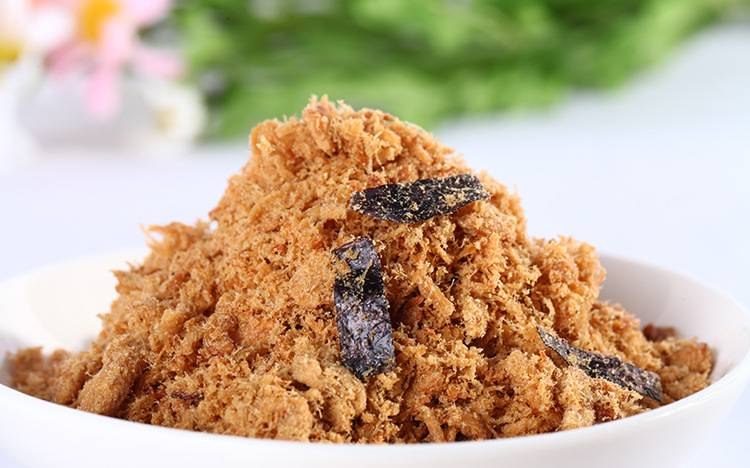
1.4 Vegetarian diced beef
Beef meat is loved by consumers because of its mellow taste and long aftertaste, but the price of beef meat is getting higher and higher due to the relatively high price of beef and its unfavorable storage, therefore, researchers began to focus on the research and development of vegetarian beef meat. The most common veggie beef dices in daily life are made from soy protein, which are usually found in the seasoning packets of instant noodles.
Zheng Pengfei [30] (2018) et al. conducted a study on soy protein vegetarian beef granules, using one-way, orthogonal experimental methods to analyze the optimal amount of soybean oil, corn starch, carrageenan, beef flavoring and other ingredients, the results show that when the amount of soybean oil, corn starch, carrageenan, beef flavoring were added to 10 percent, 20 percent, 0.7 percent, 3 percent, respectively, to produce vegetarian beef granules of color and luster, The color, texture and taste of veggie beef dices produced when the additions of soybean oil, corn starch, carrageenan and beef flavor were 10%, 20%, 0.7% and 3%, respectively, were similar to that of beef dices, and the nutritional value was higher. Therefore, the application of vegetarian beef granules in seasoning is becoming more and more common, which is closely related to the change of people's lifestyle, and the convenient application of vegetarian beef granules will not be limited to instant noodles in the future, but also in other seasonings or flavored foods.

2 Soy protein in vegetarian fast food research status quo
China has always been a major food and beverage country, and the competition in the fast food industry is particularly fierce, with vegetarian food as a product of the new era naturally having an advantage. In today's society, there are more and more vegetarians, but high-fat and high-cholesterol foods are prone to cause coronary heart disease, hypertension and other diseases. More and more fast food consumers are looking for a more nutritious, healthy and hygienic fast food that is high in protein and low in fat.
Burgers have become a global fast food product, and in addition to satisfying the need for satiety, healthy nutritional combinations have gradually become the direction of development. Li Xiaohong [31] (1994) found that the cost of the patty in a veggie burger could be reduced by adding frozen structurally separated soy protein particles with a composition of 2% protein and 78% water to the patty. The added structured proteins had a bland taste without the soya flavor of traditional soy proteins, and when flaked or minced, they showed high water holding capacity when mixed with beef. Zhao Zhiwei [32] (2013) et al. studied the addition of soy isolate proteins to veggie burgers and showed that emulsification can effectively improve the flavor, texture, elasticity, chewiness, defrosting rate, baking rate, water retention, and oil retention of the product compared with the dry and hydrated methods. It can be seen that the combination of fast food and vegetarian food is an inevitable trend in the development of fast food, taking into account people's needs for taste and texture, and the fact that the products themselves have not only low fat content, but also good organoleptic properties and can reduce costs.

3 Current research on soy protein in vegetarian cuisine
Vegetarian cuisine is based on vegetable proteins, supplemented by fruits, vegetables and other raw materials, cooked in vegetable oil, and is rich in nutrients, containing a large number of vitamins, amino acids, salts and other components, which play an important role in strengthening the relevant functions of the human body [33]. Vegetarian food is prepared in a similar way to meat dishes, but with its own unique characteristics.
According to Guo Taihong [34] (2018), the production of Chinese vegetarian dishes should be based on taste, with the aim of attracting diners, and ultimately enabling consumers to enjoy while consuming nutrients and nourishing the body. At present, the development of vegetarian dishes with soy protein is still in its infancy, and there are fewer studies on the use of soy protein as the main ingredient, and the research focuses on the addition of some soy protein ingredients in the production process of the dishes to save costs.
Meatballs, with meat filling as the main ingredient, are favored by people all over the world. In recent years, vegetarian meatballs have come to the forefront of people's attention to nutrition and health.

Chen Yuling [35] (2020) and others used soybean protein as the main raw material, fried in palm oil to make soybean protein vegetarian meatballs, and compared them with homemade pork meatballs and fish and beef meatballs, which are widely sold in the market, to determine the amino acid, protein, fat, and structural properties of the meatballs, and ultimately found that soybean protein vegetarian meatballs were the most resilient and elastic, with 52.77% ± 0.56%. 52.77% ± 0.56% and 96.84% ± 1.43%, respectively.
Yang Chunmei [36] (2011) studied the production of soybean tissue protein meatballs and used orthogonal tests to screen the additions of salt, beef flavoring paste, monosodium glutamate (MSG), and sugar in the meatballs, and analyzed the effect of the vegetarian meatballs on the flavor by combining with the principal component analysis (PCA) method. The final results showed that the best flavor of the meatballs was obtained when the additions of salt, sugar, monosodium glutamate (MSG), and beef flavor paste were 4%, 1%, 1%, and 1.5%, respectively. In addition, the water content of vegetarian meatballs, the additions of soybean isolate protein, potato starch, and soybean oil were optimized and screened, and the best systematic state of the material of the vegetarian meatballs was obtained when the additions were 30%, 20%, 25%, and 6%, respectively.
Wang Di [37] (2011) and others used soybean tissue protein as the main raw material to make vegetarian meatballs, and the formulation of vegetarian meatballs with soybean tissue protein was obtained, and the optimal production process was determined by measuring the textural properties of the meatballs. The results showed that the addition of soybean tissue protein directly affected the sensory properties of the vegetarian meatballs, such as chewiness and recovery.
In addition to vegetarian meatballs, researchers have also processed semi-finished soy protein vegetarian dishes, such as vegetarian chicken, fish, goose, and steak, to produce vegetarian dishes [39]. Soy protein has a unique organizational structure and a morphology and texture very similar to that of real meat, and its full application would be beneficial for the development of culinary dishes as well as the substitution and innovation of traditional dishes.
4 Summary and Prospects
With the development of economy and the pursuit of healthy life, vegetarian food has become very popular in recent years. Soybean is one of the main raw materials in vegetarian food, and the soy protein extracted from it can better utilize the nutritional functions of soybean, and there are relatively more researches on the use of soy protein in vegetarian food, which has the advantages of saving cost, improving nutritional value, and preventing diseases.
At present, the research on vegetarian food made from soy protein has been slightly effective, but in the process of research, there are still the following problems.
First, there is still a lack of industrialized processing and production in China, especially in the research of vegetarian diets based on soy protein. Moreover, due to China's limited involvement in vegetarian fast food and vegetarian dishes, there is still a lack of core equipment and automated production, which makes it unable to be completely self-sufficient, and therefore, the scope of the research on vegetarian fast food and vegetarian dishes is still relatively limited, and there will be more room for development in the future.
Secondly, researchers have little understanding of the special needs of specific groups of people and are unable to accurately apply the nutritional benefits of vegetarian food to food for special groups; in future research, the needs of specific groups of people can be further explored, promotion can be strengthened, and the categorization and nutritional functions of vegetarian food can be further refined, thereby increasing market share.
Thirdly, due to the complexity of the production process of vegetarian dishes and foods, the scarcity of relevant technical personnel, the shortage of basic data, and the lack of innovative and independent R&D capabilities, the vegetarian market today is characterized by a lack of a wide range of vegetarian products.
Therefore, the development of innovative vegetarian products should be strengthened, and the production process of vegetarian products should be further improved in order to achieve full mechanization and automation. It is believed that with the efforts of researchers and the development of the vegetarian industry, the soybean vegetarian diet will be able to enter a broader world.
References
[1] Wu Xin. A tentative discussion on the social impact of vegetarian culture [J]. Journal of Sichuan Culinary College, 2009, (2): 18-20
[2] Shi Yuqiang, Lu Xiuqiang, Ma Jun, et al. Application of soy protein in traditional soy products [J]. China Oil and Fat, 2017, 42(3): 155-157
[3]Juliano Uczay,Eduardo Kelm Battisti,Rafael Lazzari,et al. Fish meal replaced by hydrolysed soybean meal in diets in-
creases growth and improves the antioxidant defense system of silver catfish ( Rhamdia quelen ) [J]. Aquaculture Re- search,2019,50(5) : 1438 -1447
[4] Zuo Jinhua, Dong Haizhou, Hou Hanxue. Current status of soybean protein production and application [J]. Cereals, Oils and Fats, 2007, (5): 12-15
[5] Dai Yangyong, Cao Jian, Dong Haizhou et al. Research progress on the off-flavor of soybean food [J]. Chinese Journal of Cereals, Oils and Fats, 2007, 22(4): 50-53
[6] Hao Xiaoliang, Liu Yi. Comparison of fibrous soy tissue protein and ordinary tissue protein [J]. Food Industry Science and Technology, 2007, 28(9): 113-114, 116
[7] Feng Weijuan, Chen Zhe, Zhao Peng, et al. Comparative study of near-infrared spectroscopy and Kjeldahl nitrogen determination for the determination of protein content in soybeans and soybean meal [C]. Danone Nutrition Center 21st Annual Conference Proceedings, 2018.
[8]Gebrezgi.Proximate composition of complementary food pre- pared from maize ( Zea mays ) ,soybean ( Glycine max) and Moringa leaves in Tigray,Ethiopia[J].Cogent Food & amp, Agriculture,2019.
[9]Yusof S C,Babji A S.Effect of non-meat proteins,soy pro- tein isolate and sodium caseinate,on the textural properties of chicken bologna[J]. International journal of food sciences and nutrition,1996,47(4) : 323-329
[10]Keeton J T. Low -fat meat products technological prob- lems with processing.[J].Meat science,1994,36( 1 -2) : 261-276
[11]Liurong Huang,Shifang Jia,Wenxue Zhang,et al.Aggre- gation and emulsifying properties of soybean protein isolate pretreated by combination of dual - frequency ultrasound and ionic liquids [J]. Journal of Molecular Liquids, 2020,301.
[12] Li Chuanyun. Study on the effect of enzyme treatment on the gelation of soy protein [D]. Hefei: Master's thesis, Hefei University of Technology, 2019.
[13]Chuanyun Li,Xuefeng Wu,Dongdong Mu,et al.Effect of Partial Hydrolysis with Papain on the Characteristics of Transglutaminase ‐ Crosslinked Tofu Gel[J]. Journal of Food Science,2018.
[14]Xingfei Li,Liyang Chen,Yufei Hua,et al.Effect of pre- heating -induced denaturation during protein production on the structure and gelling properties of soybean proteins[J]. Food Hydrocolloids,2020,105.
[15] Gao Miaozi, Shao Juanjuan, Sun Hui. Modification of soy protein and research on its application [J]. Grain Processing, 2019, 44(4): 44-46
[16] Wang Haiyan. Function of soy tissue protein and its application in meat products [J]. Meat Industry, 2007, (12): 33-34
[17]Siyu Ruan,Yunliang Li,Yucheng Wang,et al.Analysis in protein profile ,antioxidant activity and structure -activity
relationship based on ultrasound-assisted liquid -state fer- mentation of soybean meal with Bacillus subtilis[J].Ultra- sonics Sonochemistry,2020.
[18] Jiang Yuxiang. Green ingredients and delicious food – taking Jinhua ham, Xuanwei ham and Spanish ham as examples [J]. Journal of Sichuan Tourism University, 2019, (4): 14-16
[19] Yuan Shulin. How to make black rice elastic ham sausage [J]. Rural Baisitong, 2019, (16): 42-43
A comparative study of the protein content of soybeans and soy flour [C]. Danone Nutrition Center 21st Annual Conference Proceedings, 2018.
[21] Fei Yingmin. Research on soy protein ham [J]. Chinese Condiments, 2010, 35 (5): 40-43
[22] Deng Yuanxi, Ma Long, Li Yan, et al. Study on the gelation process of soy protein ham processing [J]. China Brewing, 2011, (2): 182-185
[23] Li Xuelian, Huang Lixin. Discussion on the production process of soy protein ham [J]. Food Industry, 2007, (3): 31-32
[24]Cho Eun Bin,Cho Hye-Jin,Choi Misong,et al.Low high- density lipoprotein cholesterol and high triglycerides lipid profile in neuromyelitis optica spectrum disorder : Associations with disease activity and disability[ J ].Pubmed,2020.
[25]Yang Hyun Suk,Hur Mina,Kim Hanah,et al.HDL Sub- class Analysis in Predicting Metabolic Syndrome in Koreans With High HDL Cholesterol Levels[J].Pubmed,2020.
[26] Wang Jingji, Jin Jingfang. Development of plant protein-based meat floss [J]. Food Research and Development, 1998, (4): 18-19
[27] Yang Xiaoyu. Development and research of soy tissue protein food [D]. Harbin: Master's thesis, Northeast Agricultural University, 2005.
[28] Tang Chaohui, Liu Daoxin. Development and flavoring test of vegetarian sausage [J]. China Food Additives, 2007, (6): 83-87
[29] Sun Keke, Bie Yinan. Effect of supercritical extraction of allspice essential oil on the quality of vegetarian sausage [J]. China Condiments, 2019, 44(6): 154-156
[30] Zheng Pengfei, Gao Yun, Wu Jinlong et al. Development of soy tissue protein-based beef balls in traditional instant noodles [J]. Cereals, Oils and Fats, 2018, 31 (7): 56-58
[31] Li Xiaohong. Processing of low-fat hamburger patties [J]. Meat Research, 1994, (4): 37, 41
[32] Zhao Zhiwei, Zeng Maomao, He Zhiyong et al. Effect of the addition method of soy protein isolate on the quality of vegetarian hamburger patties [J]. Food Industry Science and Technology, 2013, 34 (18): 266-268, 274
[33] Niu Feifei, Sun Menghan, Zheng Lin et al. Process recipe optimization and characteristics of glutinous rice mushroom nutrition fast food sausage [J]. Meat Research, 2012, 26(8): 12-16
[34] Guo Taihong. Vegetarian cooking, taste enjoyment first [J]. Hangzhou (Weekly), 2018, (2): 56-57
[35] Chen Yuling, Yang Mei, Niu Yuting et al. Comparison of nutritional composition and texture characteristics of soy vegetarian meatballs and three kinds of meatballs [J]. Modern Food Science and Technology, 2020, 36 (1): 84-90, 7
[36] Yang Chunmei, Bao Sarina, Wu Jinhong et al. Development of soy tissue protein meatballs [J]. Food Science, 2011, 32(6): 301-306
[37] Wang Di, Chi Yujie. Optimization of the formula for soy tissue protein meatballs [J]. Food Industry Science and Technology, 2011, 32(9): 110-115
[38] Cucumber chicken [J]. Jilin Vegetables, 2009, (3): 56


 English
English French
French Spanish
Spanish Russian
Russian Korean
Korean Japanese
Japanese